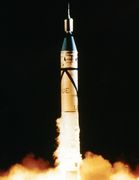Jun 1 2008
Researchers at the University of Massachusetts Amherst have received a $1 million grant from the U. S. Department of Defense (DoD) to boost the safety and performance of fuel used in thousands of satellites, space vehicles, rockets and missiles.

The UMass team will study the spray and combustion of gelled hypergolic propellants, formed from a fuel and an oxidizer that ignite spontaneously when mixed, so there is no need of an ignition mechanism to bring about combustion. Hypergolic propellants have been used for decades, and were mentioned in the movie Apollo 13 as the fuel used in the lunar module.
David Schmidt and Phillip Westmoreland will focus on fluid flow and chemistry in hypergolic propellants. The UMass Amherst research is part of a larger, interdisciplinary collaboration with Purdue and Iowa State Universities that was awarded $6.4 million by the DoD. Stephen Heister of Purdue is the principal investigator for the entire project.
“Hydrogolic fuel is related very specifically to the thruster rockets that act as guidance mechanisms on a spacecraft,” says Westmoreland, a professor of chemical engineering. “The lunar module is a prime example, but also satellites that have thrusters to help them maintain their proper orbits.”
The research will be applied very quickly by the DoD and NASA, resulting in significant payoffs in the safety and performance of rocket propellants, such as better spray patterns, enhanced mixing, shortened ignition times, controlled reaction rate, elimination of hard starts and safer storage. These improvements will also mean increased rocket efficiency and range, and increased vehicle safety.
Adding a gelling agent to hypergolic fuels is a new idea designed to prevent spills and unintentional ignition from fuel tank punctures and improve the performance of the propellants. But scientists still lack a fundamental understanding of how the newly formed gels will behave during the mixing and combustion process because liquid and gelled hypergolic fuels act very differently from each other.
“You certainly wouldn’t throw gelatinized fuel in your car and just hope for the best,” says Schmidt, a professor of mechanical and industrial engineering. “It’s pretty much the same with rockets. Before you add these safer fuels, you have to give some thought to how you’re going to have to redesign the rocket engine. One of the things we expect to change is the fuel injection and fuel mixing process. Hopefully, five years from now, we’ll have the new knowledge required to redesign the rocket engines to accommodate the gel fuels.”
Schmidt and Westmoreland will be studying key issues in the hypergolic propellant mixing system, such as spray atomization in gels, the effect on vapor pressure, droplet collision dynamics and the chemical mechanisms that must be designed to accommodate this gel behavior.
“Once you get into the world of gelling, anything’s possible,” says Schmidt. “You might get something like Silly Putty in which you stretch or shear the gels and they snap back, demonstrating elasticity. Another example is toothpaste. With toothpaste, you might squeeze a little out of the tube and it gets sucked back in. One more example is a lava lamp. These are the kinds of behavior that we’re going to have to study and get to know when hypergolic gels are mixed.”
The objective of this effort is to develop a fundamental understanding of the processes and mechanisms that control droplet formation, droplet collision and mixing, ignition and energy release in gelled hypergolic propellants. The UMass Amherst engineers will be studying these issues by applying various computer modeling and simulation tools used by engineers, and then comparing their results with laboratory tests conducted by the team of collaborators from Purdue and Iowa State.
The project is a special kind of DoD grant called a Multidisciplinary University Research Initiative or MURI, a high-profile grant obtained by forming collaborations with the very best researchers in the country.
“For UMass Amherst to be part of a successful MURI proposal is a real honor,” says Schmidt. “It confirms a level of recognition among our peer institutions and with our sponsors.”
“What we’re doing is both on the cutting edge of the technology and the cutting edge of the science needed to make those technologies work,” says Westmoreland.